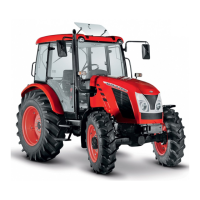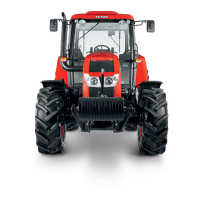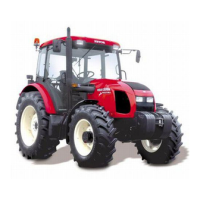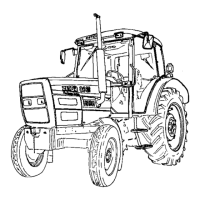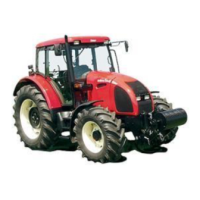
Do you have a question about the Zetor 86 41 forterra turbo and is the answer not in the manual?
| Engine Power | 82 hp |
|---|---|
| Engine cylinders | 4 |
| Rated engine speed | 2200 rpm |
| Max. Speed | 40 km/h |
| Hydraulic pump capacity | 50 l/min |
| PTO Speed | 540/1000 rpm |
| Hydraulic Remotes | 2 |
| Lift Capacity | 4200 kg |
| Rated engine power | 60 kW |
| Fuel Tank Capacity | 120 liters |
| Hydraulic pressure | 18 MPa |
| Rear lift capacity | 4200 kg |
Details on finding serial numbers for Z 8641, Z 9641, Z 10641, Z 11441 tractor models.
Details on finding serial numbers for the Z 11741 tractor model.
Essential rules for tractor operation safety.
Guidelines on appropriate attire for safe operation.
Crucial safety steps for starting the engine.
Important safety instructions for operating the tractor.
Safety regulations for transporting people and operating.
Safe procedures for tractor recovery and pushing.
Maintenance and checks requiring the engine to be off.
Key measures to prevent fires during operation and refueling.
Guidelines for protecting health and the environment.
Safe handling procedures for oil products.
Proper methods for disposing of tractor parts and liquids.
Tasks to perform daily or every 8-10 operating hours.
Important considerations for the tractor's safety cab.
Safety notes regarding the air conditioning system.
Crucial safety information for the tractor's electrical system.
Checking the fuel system for leaks and proper condition.
Procedures for checking and maintaining the engine oil level.
Checking the engine cooling system for leaks and coolant level.
Checking liquid-operated brakes and clutch for tightness.
Verifying the pneumatic brake system and tractor-trailer efficiency.
Checking the trailer hydraulic brakes for tightness.
Daily checks for the hydrostatic steering system.
Maintenance of the air cleaner and its indicator.
Checking and cleaning the cab ventilation air filters.
Ensuring tractor and trailer attaching implements are in proper condition.
Post-operation checks for front implements.
Checking tire pressure and wheel bolt tightness.
Performing a quick check of essential tractor functions.
Information about the safety cab features and access.
Procedure for opening the cab door from the exterior.
Procedure for opening the cab door from the interior.
Details on the tractor's rear window.
Information regarding the side windows.
Instructions for operating the tilting cover.
Details about the washer nozzle adjustment.
Location and description of the washer tank.
Operation of the windscreen washer control.
Information on the companion seat.
Location of storage and toolbox.
Adjustment and features of rearview mirrors.
How to adjust the seat based on driver's weight.
Adjusting the seat forward and backward.
Adjusting the seat height.
Information on the Grammer driver's seat option.
Procedure for adjusting seat to driver's weight.
Adjusting the seat's forward/backward position.
Adjusting the steering wheel's angle and height.
Setting the steering wheel's angle.
Adjusting the steering wheel's height.
Overview of heating, AC, and radio controls.
Function of the heating valve controller.
Operation of the fan speed controller.
How to operate the air conditioning system switch.
Controlling air circulation within the cab.
Ensuring correct operation of HVAC systems.
Steps for quickly heating the cab interior.
Steps for rapidly cooling the cab interior.
Ensuring proper HVAC system function.
Post-cooling adjustments for temperature regulation.
Details on HVAC vents and radio speaker placement.
Using HVAC vents for effective windscreen defrosting.
Overview of the analog instrument dashboard.
Explanation of each instrument on the dashboard.
Explanation of various warning and indicator lights.
Overview of the digital instrument dashboard.
Details of instruments on the digital dashboard.
Location and function of signal lights and pushbuttons on digital display.
Identification and function of various control switches and levers.
Operation of the light changeover switch.
Engaging the front axle drive for improved traction.
Operation of the warning light switch.
Switching between hood and cab lights.
Activating the differential and axle locks.
Controls for lights and horn.
Location and function of the switch box.
What happens when the key is in the off position.
Tractor operation with the key in the 'I' position.
Tractor functions with the key in the 'II' position.
Using the electronic hand throttle for speed control.
Operation of the hand-operated fuel lever.
How to stop the engine using the controller.
Identification and function of tractor pedals and levers.
Operation of the main gearshift and reverse levers.
Shifting between road and reduced speed gears.
Shifting PTO shaft speeds.
Controls for the hand brake and trailer hitch.
Location of the hydraulic control panels.
Control for the external hydraulic circuit.
Controls located on the cab R-H column.
Safety procedure for disconnecting the battery.
Identifying the location of various plates and warnings.
Information about the fuel tank capacity and safety.
Location of the fuel tank drain plug.
Table showing fuel consumption data.
Diagram illustrating the electronic engine control system.
Function of the MAX push button for engine speed.
Function of the MIN push button for engine speed.
Function of the MEM push button for memory operations.
Meaning of the H/O indicator lamp status.
Explanation of the governor's operational functions.
Steps to set and memorize temporary engine speeds.
How to reset or delete temporary engine speed memory.
Steps to set and memorize permanent engine speeds.
Recalling permanent memory when H/O lamp is off.
Recalling permanent memory when H/O lamp is on.
Resetting memory to revert to pedal control.
Setting entry/exit speeds for tillage and storing in memory.
Setting operating speed and storing in temporary memory.
Tillage operation using temporarily memorized speed.
Resetting temporary memory and recalling entry/exit speeds.
Resetting permanent memory and memorizing operating speed temporarily.
Tillage with temporarily memorized operating speed.
Setting the PTO shaft speed.
Setting a constant travel speed.
Engaging and setting PTO speed for 540/1000 RPM.
Temporarily memorizing the PTO speed.
Tractor maneuvering and resetting temporary memory.
Essential checks before starting the tractor engine.
Troubleshooting steps when the engine won't start.
Prohibited methods for starting the tractor engine.
Procedure for starting the engine on specific models.
How glow plug system failures are indicated.
Starting procedure for Z 11741 with electronic thermоstart.
Starting the Z 11741 engine with glow gratings.
Troubleshooting glow grating system failures.
Step-by-step guide for starting engines with glow gratings.
Information about the cooling liquid heater.
Using the heater to aid engine starting.
Actions to take immediately after engine start.
Proper procedure for warming up the engine.
General principles of gear shifting.
Operation of the reverse gearshift lever.
Shifting between road and reduced speed gears.
Procedure for shifting to a higher gear.
Procedure for shifting to a lower gear.
Operation of the three-stage torque multiplier.
How torque multiplier gears are indicated.
Shifting gears using the torque multiplier.
Adjusting travel speed using two-speed gears.
Step-by-step guide to starting the tractor in motion.
Safe procedures for driving uphill.
Safe procedures for driving downhill.
Description and operation of the foot brake system.
Information about the front cardan brake.
Control of pneumatic trailer brakes.
Warning signal for low air pressure.
Description of single and twin-hose brake systems.
Details on single-hose brake operation.
Details on twin-hose brake operation.
Information about the air tanks capacity.
Control and operation of trailer hydraulic brakes.
How to control the front driving axle engagement.
When and how to use the front drive axle.
Ensuring adequate clearance for the propeller shaft.
Procedures for safely stopping and parking the tractor.
How to stop the engine on specific models.
How to stop the engine on the Z 11741 model.
Steps to take when leaving the tractor.
Warning signals for hydrostatic steering failure.
Core principles for breaking in a new tractor.
Specific running-in procedures for the initial 10 hours.
Maintenance after 10 operating hours.
Maintenance after 50 operating hours.
Maintenance for specific models after 70 hours.
General maintenance after 70 operating hours.
Maintenance after 100 operating hours.
Using the front hook for towing and rescue.
Attaching two-axle or lighter single-axle trailers.
Details on the mechanical tail of the hitch.
Procedure for connecting the automatic tail hitch.
Adjusting and positioning the swing tie rod.
Hitch for single-axle trailers with a swing tie rod.
How to replace the tow hook with a swing tie rod.
Specifications for the swing tie rod.
Adjustability and coupling of the tow bar.
Operating supporting hooks via mechanical control.
Operating supporting hooks via hydraulic control.
Connecting semi-trailers and trailers.
Maximum static vertical load limits for trailer hitches.
Load capacities for single-axle trailers with specific tractor models.
General guidelines for PTO shaft operation.
How to control front and rear PTO shafts.
Shifting rear PTO shaft speeds.
Procedure to change rear PTO shaft speed.
Information about PTO shaft tails.
Sense of rotation for the front PTO.
Importance and maintenance of PTO shaft guards.
Maximum power transfer capacity for specific models.
Maximum power transfer capacity for Z 11741.
Driving machines with high inertia, including overrun clutch use.
General overview of the hydraulic system.
Details about the hydraulic system pump.
Location of the EHR B control panel.
Location of the mechanical control panel.
Function of the outer hydraulic circuit.
Safe procedures for connecting and disconnecting quick couplers.
Table showing oil amounts for outer circuit outlets based on operation type.
Operation of the outer circuit control lever.
Description of rear hydraulic outlets.
Controlling single-acting hydraulic cylinders.
Controlling double-acting hydraulic cylinders.
Function and types of selective control valves.
Details on the two-section SCV.
Details on the three-section SCV.
Explains functions of different control levers.
Details on rear hydraulic outlets and their connections.
Details on front hydraulic outlets.
How to connect machines to the outer hydraulic circuit.
Overview of the hydraulic control elements.
Description of the hydraulic inner circuit.
How the inner circuit control lever operates.
Choosing the control mode for the hydraulic system.
Adjusting the system's response rate.
Additional hydraulic control via electro-pneumatic system.
Using the cab control switch for implement lifting.
Using fender-mounted switches for implement attachment.
Safety precautions when using electrical switches for hitch control.
Diagram of the EHR B hydraulic system.
Explanation of the functions of control elements.
Operation when the lifting device is switched off.
Steps to remove the system's blocking mechanism.
Performing a fast dip of the implement.
Procedures for transporting implements.
Engaging the stop position for the three-point hitch.
Using the swing compensator for heavy implements.
Setting the upper limit for the three-point hitch position.
Adjusting the speed at which the hitch lowers.
Operating the hydraulic system in free position.
Setting up the system for field operations.
Using the rear control for implement attachment.
External pushbuttons for controlling the hydraulic system.
Safety precautions when using external pushbuttons.
How EHR-B failures are signaled.
Detailed explanation of EHR-B failure signal patterns.
Explanation of EHR-B light failure codes.
Details on the rear three-point hitch.
Essential safety rules for three-point hitch use.
Steps for attaching machines to the hitch.
Information on lower tie rods with extendable terminals.
Attaching machines using CBM hooks.
Procedures for blocking side swings of lower tie rods.
Details about the top link and its adjustability.
How top link position affects hydraulic response.
Information on the front three-point hitch.
Operation of the front three-point hitch controls.
Adjusting and locking the front hitch.
Adjusting the throttle valve for lowering speed.
Locking implements in hitch forks.
Safe driving practices with front-suspended implements.
Adjusting front axle wheels for different tracks.
Correct toe-in adjustment for front driving axles.
Adjusting the stops for front driving axle wheels.
How to change the rear wheel track.
Procedure for setting the rear wheel track.
Ballast weights for the rear wheels.
Location and type of lower ballast weights.
Ballast weights for the front of the tractor.
Ballast weights for the front three-point hitch.
Valve used for filling tires with liquid.
Step-by-step guide for filling tires with liquids.
How to drain liquid from tractor tires.
Safety procedure using blocks on front wheels.
Table of maximum liquid weights for different tire sizes.
Procedure for removing front bonnet panels.
Procedure for removing the rear bonnet panel.
Daily check of engine oil level.
Steps for draining engine oil.
Replacing the engine oil filter.
Procedure for filling oil into the engine.
Replacing the fuel filter cartridge.
Cleaning the rough fuel filter.
Steps to bleed air from the fuel system.
Routine maintenance for the air cleaner.
Removing and regenerating the main air cleaner cartridge.
Removing the locking insert.
Attention points when replacing air cleaner cartridges.
Correct positioning of the discharge mouth after cartridge replacement.
Ensuring filter tightness after assembly.
Replacing the hydrostatic steering filter cartridge.
Bleeding air from the hydrostatic steering circuit.
When and how to replace hydrostatic steering hoses.
Procedure for changing the engine cooling liquid.
Identification of drain holes and plugs.
Checking and changing gearbox oil.
Steps after draining oil, including cleaning and refilling.
Locations for lubricating and filling the front driving axle.
Procedures for front wheel reducer oil.
Maintenance of the front PTO shaft box.
Checking and replenishing brake fluid.
Cleaning filters for the heating unit.
Key maintenance tasks for the AC system.
Draining condensate from air storage tanks.
Verifying the tightness of pneumatic systems.
Information on pneumatic brake operating pressure.
Regular checks and servicing for tires.
Correct procedures for inflating tires.
Recommended tire inflation pressures for front wheels.
Recommended tire inflation pressures for rear wheels.
Tire specifications for driving wheels (diagonal and radial).
Procedures for storing the tractor.
Checking engine belt tension.
Checking air conditioner compressor belt tension.
Checking engine belt tension on Z 11741.
Procedure for tightening cylinder heads.
Adjusting valve clearance on specific models.
Adjusting valve clearance on Z 11741.
Setting up injectors on specific models.
Setting up injectors on Z 11741.
Adjusting the brake pedal's free play.
Bleeding the tractor's brake system.
Steps for bleeding the rear brake system.
Adjusting the clutch pedal's free play.
Bleeding the clutch hydraulic circuit.
Bleeding the front propeller shaft brake.
Verifying the foot brake's proper adjustment.
Adjusting the foot brake mechanism.
Adjusting the parking brake mechanism.
Replacing brake segments on the front propeller shaft.
Adjusting lifting tie rods for single-axle trailers.
Adjusting the Bowden cable.
Calibrating the digital dashboard for travel speed.
Overview of the tractor's electrical equipment.
Fundamental service guidelines for electrical systems.
Information on the battery and its switch.
Procedures for maintaining the storage battery.
Steps for charging and maintaining the storage battery.
How to identify the battery's charged status.
Guidelines for storing batteries with electrolyte.
Location and monitoring of the alternator.
Proper maintenance procedures for the alternator.
Location and accessibility of the fuse box.
How to check and adjust tractor hood lights.
Procedures for adjusting tractor hood lights.
Checking and adjusting cab roof lights.
Table indicating bulb locations and specifications.
Specific maintenance differences for Z 11741.
General tractor inspection and maintenance schedule.
Lubrication schedule for specific tractor models.
Information on medium repairs for specific models.
Checking turbo-blower for play and tightness.
Greasing hydraulic brake components.
Details on major overhaul for specific tractor models.
Maintenance after major overhaul of tractor assemblies.
Recommended oils for over-charged engines of specific models.
Recommended oils for Z 11741 over-charged engines.
Recommended transmission oils for specific models.
Recommended oils for front driving axles.
Recommended oil for hydrostatic steering.
Recommended plastic lubricants.
Recommended liquids for hydraulic brakes.
Recommended fuels for tractor operation.
Cooling system liquids for specific models.
Cooling system liquids for Z 11741.
Table of operating liquids and their capacities.
Technical specifications for Z 8641-11441 engines.
Technical specifications for Z 11741 engines.
Maximum admissible load for the front axle.
Maximum admissible load for the rear axle.
Maximum admissible load for tractor-machine combinations.
Steering ability based on front axle weight portion.
Front tire loading capacities for specific models.
Percentage alteration of tire capacity based on speed.
Front tire loading capacities for Z 11741.
Percentage alteration of tire capacity for Z 11741.
Rear tire loading capacities for specific models.
Percentage alteration of rear tire capacity based on speed.
Rear tire loading capacities for Z 11741.
Percentage alteration of rear tire capacity for Z 11741.
Table of front tire dimensions.
Table of rear tire dimensions.
Table of forces exerted by the tractor.
Tractor power output specifications.
Speed tables for Z 8641-11441 Forterra tractors.
Speed tables for Z 11741 Forterra tractors.
Specifications for the independent rear PTO shaft.
Specifications for the independent front PTO shaft.
Turning diameter specifications for specific models.
Turning diameter specifications for Z 11741.




